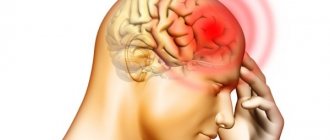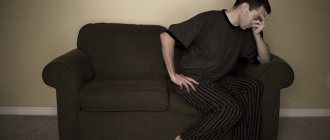Neurological diseases are detected using instrumental and laboratory diagnostic methods. Laboratory tests include blood tests (clinical, biochemical and various types of immunological), as well as lumbar puncture of cerebrospinal fluid.
The most informative in diagnosing neurological pathology is instrumental diagnostics carried out using radiation, ultrasound and electric wave methods.
Electroencephalography
The procedure is designed to test the bioelectrical activity of the brain by capturing, amplifying and recording the electrical impulses it generates. In this way, structural and organic pathologies of the central nervous system are identified - epilepsy, neoplasms, migraines, concussions and other injuries, as well as their consequences, cerebral palsy, etc.
All methods used at the Trit clinic have no absolute contraindications and are classified as non-invasive. Diagnostics are performed using modern equipment, characterized by increased sensitivity and accuracy. The received data is digitized and then decrypted by highly qualified specialists.
Examples
The patient may have language difficulties, such as problems understanding or producing speech (aphasia), and an inability to name objects (anomia) or produce sounds (dysarthria). Sometimes there is a loss of coordination and difficulty performing complex movements.
Damages to other structures of the nervous system lead to changes in vision - double vision (diplopia), a decrease in the field of vision, or sudden blindness. In some cases, there is a strong gag reflex, frequent choking and difficulty swallowing. When the cortex of the frontal lobe of the brain is damaged, a change in personality occurs, which can manifest itself as causeless rage or inappropriate jocularity, apathy, and a tendency to engage in antisocial behavior.
Other examples of localized brain damage include Bernard-Horner syndrome, which is caused by disorders of the sympathetic nervous system.
It is found in humans, dogs, cats and horses. There is unilateral drooping of the eyelids, cessation of sweating on a certain side of the face, and a sunken eyeball.
Causes
Anything that harms or destroys the nervous system can lead to focal damage. Among the most common causes of this symptomatology are:
- diseases of one nerve or a group of them;
- various infections;
- brain tumors;
- blood vessel abnormalities, such as vascular malformation;
- strokes;
- traumatic brain injuries;
- degenerative nerve diseases;
- cerebral palsy;
Depending on the mechanism of action, the nature of the lesion and its location, various motor and sensory disorders occur.
Diagnostics
If symptoms of focal neurological deficits appear, you should immediately consult a doctor. To make an accurate diagnosis, in addition to the patient’s medical history, you will need to provide the following information:
- where loss of function or abnormal sensations are located;
- when the problem began and how quickly it changed;
- whether there were increases or decreases in symptoms;
- what kind of violations are observed;
- other symptoms should be indicated, even those not directly related to the nervous system;
If a stroke occurs, it is very important to get the patient to the hospital as soon as possible. Intense and sudden movements should be avoided. Before the ambulance arrives, the patient should not be allowed to eat or drink, since paralysis of the swallowing organs can cause suffocation.
It is recommended to lay the person so that his head and neck form one line, the angle of which should be about 30° to the horizontal.
If focal neurological disorders are detected, a diagnostic examination of the nervous system is necessary. Tests and tests should identify the affected areas, with the type of test depending on the symptoms observed. As a rule, the following research methods are used:
- MRI - magnetic resonance imaging (primarily of the head, neck and back);
- CT - computed tomography;
- ENMG - electroneuromyogram;
- spinal tap;
If there is a suspicion of a tumor lesion, the patient is sent to the oncology center at the place of residence, where a set of examinations is carried out to confirm and refute the diagnosis.
Symptoms of the disease
In many cases, a person can independently determine by the symptoms that appear whether he or another person has a neurological disease.
Among the signs are the following:
- impaired speech ability;
- sleep disturbance, depression;
- pain in the legs or arms, chest, neck, back;
- loss of sensation;
- impaired motor activity, frequent fainting;
- decreased hearing and vision;
- numbness, convulsions, trembling of individual parts of the body, impaired motor functions;
- fecal and urinary incontinence.
These are alarming symptoms; an accurate diagnosis can be made during a consultation with a neurologist.
Damage to the extrapyramidal nervous system
Cerebellar lesion
Cerebellar lesions usually cause problems with balance and motor coordination and may present with the following symptoms:
- ataxia - unsteady and clumsy movements of the limbs or torso;
- inability to coordinate fine motor skills (tremor, poor finger-nose test);
- dysdiadochokinesia - the inability to perform rapid alternating movements, for example, quickly bend and straighten fingers; voluntary eye movements are inhibited in extreme positions and lead to saw-tooth movements (nystagmus).
Preventive measures
Prevention allows you to prevent the development of neurological diseases, and also helps to maintain the achieved results in their treatment. Basic recommendations for all groups of patients (with congenital and acquired pathologies of the nervous system):
- consult a doctor promptly if alarming symptoms appear;
- undergo regular medical examinations (especially for previously diagnosed diseases of the nervous system, including those in remission);
- follow the principles of a healthy lifestyle (eat rationally, give up bad habits, regularly take walks in the fresh air);
- devote time to moderate physical activity (in the absence of contraindications);
- maintain a sleep-wake schedule;
- exclude or limit the effect of provoking factors (stress, high psycho-emotional stress);
- practice autogenic training to restore mental balance during stress and relieve emotional tension.
If you have symptoms of neurological disorders, as well as to get an alternative opinion on the treatment of such diseases, contact the neurologists of the Consultative and Diagnostic Center (formerly the National Diagnostic Center).
Application of compresses
Diagnosis of neurological diseases
Neurology is a branch of medicine devoted to the study of the proper functioning of the nervous system, diagnosis of pathology and treatment. Neurology diagnostics involves a combination of three components: a thorough questioning and examination of the patient, instrumental and laboratory tests. Regardless of the development of modern diagnostic methods, it is a qualified and comprehensive examination of the patient that sometimes plays the most important role in making the correct diagnosis. Thanks to examination and questioning, it is possible to make a presumptive diagnosis, on the basis of which a strategy for diagnostic and therapeutic measures can be developed.
Rules for examining a patient with neurological pathology
- The examination of the patient is aimed primarily at diagnosing disorders or changes in consciousness, the ability to navigate one’s own personality, space and time. Upon examination, it is also possible to identify various disturbances of consciousness: confusion or absence. After this, the neurologist begins to assess cerebral symptoms, represented by complaints of dizziness, headaches, nausea, vomiting and/or meningeal symptoms.
- When studying peripheral nerves, attention is primarily paid to the cranial nerves, which provide movement of the head muscles, sensitivity of the skin and mucous membranes, smell, hearing, vision, taste, movements of the eyeballs and other functions.
- At the end of the study of the cranial nerves, the neurologist evaluates the patient’s motor sphere: strength and muscle tone, involuntary movements, tendon reflexes, etc. The finger-nose test and the Romberg position allow us to assess how the cerebellum regulates movements.
- The study of sensitivity affects two areas: deep muscle and superficial cutaneous. This research method is carried out using various irritants that affect the mucous membranes, skin and sclera of the eyeballs.
- Smell, taste, hearing, vision and the functioning of the vestibular apparatus are assessed separately.
- Checking the functioning of the cardiovascular system and skin glands must be carried out, since the work of the autonomic nervous system is of enormous importance in the normal functioning of the entire body as a whole. It is necessary to identify specific symptom complexes, on the basis of which a conclusion can be made about the predominance of the parasympathetic or sympathetic part of the nervous system.
- Neurology also affects the sphere of higher nervous activity, intertwining with psychiatry, assessing intelligence, learning ability, thinking and memory.
Without correct diagnosis, it is impossible to begin effective treatment for neurology , since the success of therapy and the patient’s recovery depend on this. For initial diagnosis, it is best to contact a neurological center with the most modern equipment and qualified specialists. Very often, positive dynamics in treatment depend precisely on the professionalism of the attending physician. Only extensive experience in the practical work of a specialist, a careful examination of the patient, the availability of high-quality equipment and the improvement of diagnostic methods make it possible to identify the slightest deviations in the functioning of the nervous system. When choosing a neurology center for examination and subsequent treatment, you should take into account the qualifications of neurologists and reviews of patients who have undergone treatment there.
Information described in the section
The section describes information about what diseases occur in the field of neurology, symptoms, causes and methods of treatment.
Diseases most common in this area:
- osteochondrosis;
- rachiocampsis;
- arthritis, arthrosis;
- cerebral palsy;
- vegetative-vascular dystonia;
- epilepsy;
- Parkinson's disease.
This is not a complete list of diseases treated by neurologists. Some of them can be successfully cured, while others require constant monitoring by a doctor and lifestyle adjustments. Facts confirmed by numerous studies and observations of patients allow us to independently assume the presence of the disease in a person. A complete and reliable picture is established by the doctor during the necessary diagnostic process.
In the neurology section you can find tips and secrets that are of great benefit to the reader.
Among them are the following:
- types of neurological diseases in children and adults;
- symptoms and diagnostic methods;
- consequences of diseases and possible treatment methods that can only be prescribed by the attending physician;
- methods of disease prevention;
- Tips for maintaining a healthy lifestyle to prevent disease.
Major neurological diseases
The most common neurological diseases encountered in patients are:
Pain syndrome can be both chronic and acute.
Headache is a disease familiar to most people; may be acute or chronic. In the latter case, patients complain of headaches, which recur for 15 days per month.
Migraine is a disease characterized by recurrent attacks of intense headaches. Usually the attack is localized in one half of the head, accompanied by nausea, vomiting, and increased sensitivity to light and sounds.
Dizziness is a symptom that can accompany a variety of neurological diseases. The patient complains of an imaginary sensation of rotation, translational movements of his own body or surrounding objects.
Fainting is a sudden loss of consciousness that occurs as a result of impaired cerebral circulation and brain hypoxia.
Osteochondrosis is pinching of the nerve roots that extend from the spine as a result of wear and deformation of the intervertebral discs. Pain in this case can be not only in the back, but also in the chest, legs, shoulders, neck, etc.
A stroke is a sudden disruption of cerebral circulation, as a result of which nerve cells are damaged and die, and brain functions are partially disrupted.
Extrapyramidal disorders are disorders of the brain structures that are involved in controlling movements and maintaining muscle tone.
Parkinsonism is a neurological syndrome characterized by rigidity (sharp increase in muscle tone), hypokinesia (slowness of movements) and trembling hyperkinesis (rest tremor, which is expressed in trembling of the limbs).
Causes of neurological diseases
Neurological diseases are caused by damage to the brain, spinal cord, and peripheral nerves.
The most common causes of the disease are:
- genetic predisposition
- congenital malformations of the nervous system
- injuries
- tumors, inflammatory diseases
- infectious diseases
- vascular and endocrine disorders
- improper load on the spine
- stress









